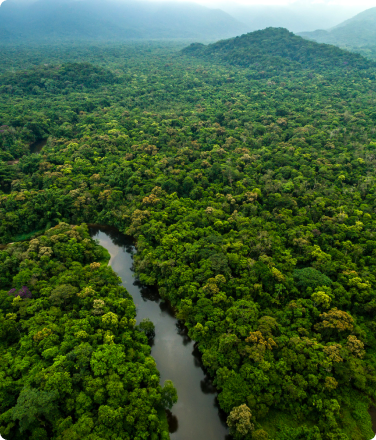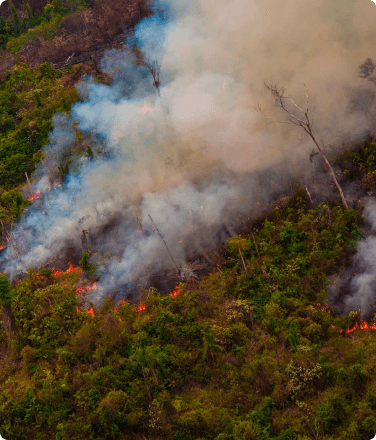At the 2021 United Nations Climate Change Conference in Glasgow, Scotland, member nations will meet in a Conference of Parties to discuss their shared ongoing commitment to muting the effects of the climate crisis.
A UN report, released earlier this year, reveals that continuing a “business as usual” scenario will be cataclysmic. It is imperative that nations take strong steps to prevent further damage, and that they keep previously-made commitments (referred to as “nationally determined contributions,” or NDCs) to stem the buildup of carbon emissions in the atmosphere.
Read Rainforest Foundation US’s response to the UN report.
Guyana’s NDC pledge promises—amongst other things—to reduce the deforestation rates of the timber and mining industries in the country while simultaneously designating more than 7,700 square miles (2 million hectares, an area the size of Massachusetts) for conservation in the nation’s Nationally Protected Areas System by 2025.
Making good on that promise is imperative, with the Guiana Shield playing a vital role in stabilizing weather patterns which have repercussions on rainforest ecosystems across the continent. But the discovery of large oil and gas deposits within the nation’s jurisdiction could jeopardize much of Guyana’s forests—especially if indigenous peoples’ organizations in Guyana aren’t adequately equipped to fight back against illegal incursions on their territories.
The Connection Between Oil, Deforestation, and Indigenous Institutions

Guyana’s oil deposits are not below the rainforest floor; they’re offshore. But because Exxon—the company extracting the oil—is paying royalties to the Guyanese government for the right to drill, oil and gas money will bring an influx of cash to the nation. With that money, the country is primed to invest in infrastructure development, large-scale agriculture, and mining in the heavily forested interior.
With new roads and economic development comes the certainty that the territories of indigenous peoples will be encroached upon.
“We’re already seeing it happening,” says Michael McGarrell, a Geographic Information Systems Specialist and Forest Policy Officer for the Amerindian Peoples Association (APA) in Guyana. “Loggers push roads deeper into the forests. Once they develop the road infrastructure, miners inevitably follow. Once infrastructure is developed, destruction comes with it.”
According to McGarrell, that’s already happening around Karisparu Village, where gold miners have already driven indigenous peoples from their homes. Now, McGarrell says, the government is making plans to develop Karisparu’s airstrip, ensuring still more traffic to the area.
Nationwide, an influx of mining and logging opportunities in the coming years could go unchecked if indigenous peoples’ organizations lack the institutional power needed to repel illegal threats and help forest communities understand their rights against those threats.
Tony James, a Wapichan elder and the former Chief of Chiefs in the South Rupununi region of Guyana, says that without village councils and regional councils working with their communities to make informed decisions, extractive industries can exploit them.
“They take advantage of our innocence,” says James. “Village councils need to know their strength. They’re protected under the law: the Amerindian Act of 2006, the Constitution of Guyana. The rights to our lands, our territories, and our resources are so important.”
Many district councils are not recognized by the national government as legally representing the communities they serve. McGarrell says that the North Pakaraimas District Council, one such district council located in Guyana’s central Region 8, is severely hamstrung by lack of legal recognition, noting that, “Once there’s legal recognition, our work will be recognized by the federal government as legitimate. With legalization, it’ll become way easier.”
Without that recognition, many areas occupied by indigenous peoples are subject to a legal power vacuum, leaving them vulnerable to government bodies with authority to grant mining and logging concessions. Within that vacuum is also where one village’s uninformed deal with extractive industries can go unchecked by the others, thus bringing deleterious impacts on neighboring communities.
“Mining doesn’t just affect one area,” explains James, noting that one village’s agreement to allow gold miners into the Marudi Mountains of the South Rupununi has brought mercury poisoning to surrounding communities.
In Guyana, indigenous communities are only legally titled at the village level, as current laws allow; this ignores peoples’ collective rights to historical hunting, fishing, and traditional use areas and sacred sites in Guyana.
As with the collective power of district councils, landscape-level land titling could also help strengthen the position of indigenous peoples who wish to keep their forests intact.
“Because we have individual titles to these parcels of land, we’re targeted individually,” James says. “The collective ownership of our land is paramount to the protection of our forests.”
A Solution for The NDCs
In their NDC, Guyana’s government pledged to conserve thousands of square miles of forests while simultaneously reducing deforestation from extractive industries. Rainforest Foundation US (RFUS) is working with partners in Guyana to make good on both goals.
With regards to land conservation, we’ve spent the last several years working with the APA in a series of Land Tenure Assessments that have mapped out the full extent of indigenous peoples’ lands through most of Guyana—including large segments of the country that remain untitled. The goal is to have more than 14,000 square miles (3.67 million hectares) of land titled to their traditional stewards. The federal government could meet their land conservation goal by this simple recognition.
Read more about land rights in Guyana.
There are several scientific studies that show that indigenous peoples are the most effective protectors and managers of tropical rainforests, regularly outperforming even national parks.
RFUS is also working in Guyana with village councils, district councils and national indigenous peoples’ organizations to ensure these institutions are the strongest they can be. Through grants from the Swedish Postcode Foundation’s Tropical Forest Initiative and Norway’s International Climate and Forest Initiative, we’re helping strengthen regional organizations while also supporting community forest monitoring along the lines of our Rainforest Alert forest patrol program.
Watch this video about Rainforest Alert.
Until these lands are recognized and regional organizations in Guyana are empowered to fight for their communities, they remain vulnerable to extractive industries—or, perversely, expulsion from their traditional homes under the rhetoric of “forest conservation.”
Moreover, recognition of those lands brings a multitude of benefits from the local level—by ensuring peoples’ rights to a healthy environment and prosperous, sustainable livelihoods—to the global level, where they sustain rich biodiversity and essential carbon sinks to support a liveable planet for all.
“If we want to survive what is happening in today’s world, all you have to do is legally recognize indigenous territories,” says James. “Pressure our government to give us these lands. I’m trying to protect the land for the future generations of my people, and for humanity as a whole. We have been protecting these lands all along.”



